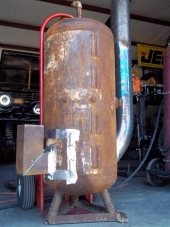Brand new here!
I just started building a 4" rocket stove for heating the garage.
Wisconsin winters can get to -20 deg F but more typical is between 10-20 deg low at the times I'm in the garage workshop.
I found a 16" diameter compressor tank, 4" inner dia. round riser pipe (1/4" wall) and 4" outer square feeder pipe (3/16" wall)
Have already cut open the tank and welded the horizontal feeder to the riser.
I plan to fit a vertical feeder to the horizontal one because the design goal was to stick a long 2x4 in the feeder and just let it be slowly consumed. I also have 100 year old dry lath that burns fast and HOT.
The combustion riser will be insulated with vermiculite inside a stove pipe.
No mass to speak of, just instant heat for taking the chill off the garage.
I tend to get artsy with some projects so the stove's feet will be like those curvy 1950s sci-fi rocket fins

I may later make a "nose cone" with multiple heat dissapating fins, to shape it more like a rocket ship and less like a bomb.
QUESTIONS:
About how long a horizontal exhaust can the stove push? Internal riser is about 24".
Can I go vertical out the roof? (~10ft)
I can send it out a window opening if needed.
If the stove proves itself, it may be rebuilt or prettied up and brought into our house.
A possible modification at that time would be to pump heated water down to storage barrels in the basement, either for radiators or just slow, passive heating of the basement space. Our gas forced air furnace will recirculate it throughout the house.
That is WAY in the future though.
I can post pics later if there is interest.
--Steve










